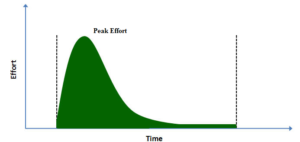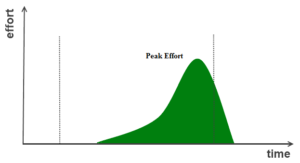Statement and Explanation of Parkinson’s Law:
- In 1958, C. Northcote Parkinson wrote a satirical book describing human behaviour. The book was entitled, Parkinson’s Law: The Pursuit of Progress and is the source of the well-known law: “Work expands to fill the time available for its completion.” One everyday example given in his book is that of two people writing a postcard. An elderly, retired person might spend hours choosing the right card, take great pains to craft a personal message and then walk to the post office to mail it. On the other hand, a busy businessman is to pick the first card he spots, write a quick note and mail it on the way home. Same work but different time allocation, because for the retired person more resource time is available while for the businessman it is scarce.

- This law was actually proposed by him to explain tthe ime-consuming nature of bureaucracy in Great Britain. Actually, it is true everywhere. He found that the bureaucracy insists to continue hiring more and more people to achieve the same results. What happened to the “free” time now available to those who were responsible for the results in the first place? Parkinson was surprised to discover they were just as busy as they had been before the addition of layers of assistants. The end result of all of their business was the same economic output as they had achieved before the hiring binge, but they found ways to expand the work and remain “busy.” Emails between the various layers of employees exploded. Of course, this internal correspondence had to be checked for proper spelling and grammar. And someone had to manage the escalating staff. In fact, in the specific case he describes in his book, seven officials ended up doing the same amount of work as one had done before. In short, “Officials make work for each other.”
Corollaries of Parkinson’s Law:
- Data expands to fill the space available for storage.
- Storage requirements will increase to meet storage capacity.
- Expenditures rise to meet income.
- A modern version is that no amount of computer automation will reduce the size of a bureaucracy.
- The Stock-Sanford Corollary to Parkinson’s Law reads, “If you wait until the last minute, it only takes a minute to do.”
- “Parkinson’s Law” could be generalized further still as:
- The demand upon a resource tends to expand to match the supply of the resource. OR The amount of time which one has to perform a task is the amount of time it will take to complete the task.
Explanation of Corollaries of Parkinson’s Law:
- If a task can expand to fill the time allotted, then conversely, the effort given can be limited by limiting the allotted time, down to a minimum amount of time actually required to complete the task. This is often associated with procrastination. This generalization has become very similar to the economic law of demand; that the lower the price of a service or commodity, the greater the quantity demanded. Today, there are many variations on this principle. For example, Parkinson’s Law of Data states, “Data expands to fill the space available for its storage.” (Check your hard drive) Parkinson’s Law of Bandwidth Absorption claims, “Network traffic expands to fill the available bandwidth.” And so on. So what started as a humorous commentary by Parkinson has become an axiom in many parts of our lives.
- However, there is good news in all of this. And that is the inverse of Parkinson’s Law: “Work contracts to fill the time available for its completion.” Take examples of many students. They say they have no time available for their studies during their normal course. They give different reasons to show their occupancy with their work. This is because their resource time is available in larger quantity in a normal course. Hence their work expands to fill this time. But the same amount of study they are able to do one day before the exam. Because now the resource is scarce and there is no way out but to complete the study. Thus they are able to fit their studies in this one day only. Thus the work reduces as the resource time reduces. When you are reducing the work and if you use 80/20 Rule. You will be doing the smart work rather than the hard work. This phenomenon is known as student’s syndrome.

- See behaviour of a child. Ask him or her to help you with your daily household work or ask them to do studies. The child may take a long time to do it. But if you say “I’ll allow you to play with your friends after completing this task”. Just see how fast the child completes the task, almost in no time.
- The Stock-Sanford Corollary to Parkinson’s Law reads, “If you wait until the last minute, it only takes a minute to do.” So, why don’t we have this sense of urgency throughout the year? It is simply because there is more time available. What we don’t get done during the day, we can finish that evening. The week’s surplus of work can be taken home for the weekend. Thus we slip into the habit of procrastination; the arch enemy of a balanced life.
How to Challenge Parkinson’s Law in Everyday Life:
- Make a practice of focusing on your high-value tasks until they are complete. Free up every minute possible by doing those things that yield the highest return on your efforts, delegating everything that someone else can do. Ensure you stay focused and maintain a sense of urgency in all that you do while at work. In this way, you will defy Parkinson’s Law and lay the foundation for achieving one of the goals of doubling your time off.
- Stop spending hours of your time on one activity.
- Try to squeeze your work into several hours and enjoy free time however you like.
- Do not attempt to apply this law in the workplace. Your boss may ask you to do twice the amount of your daily tasks! If you get a bonus for extra work, then it is fine. If this is not the case, this law should be disregarded.
- If you are trying to establish your own business or are already a business owner, this law will save you a great deal of time and many headaches.
- Focus solely on one piece of work within the given deadline and you will achieve much better results. When the work has a deadline you will naturally eliminate all the unnecessary work and concentrate only on essential tasks.
- Therefore it is better to give yourself two hours time to accomplish quite a large project rather than to dedicate a whole week for that.
- When you apply Parkinson’s law to your daily activities you will notice how much spare time you have left. This law will make you productive and pro-active.
Action Plan:
- Plan your daily activities in advance.
- Enter into your daily planner the deadlines for each activity.
- Try to keep the time frames short, so as to achieve better productivity.
- Try to stay within the deadline no matter what you do.
- Skip the unnecessary tasks if you see that you are likely to go over the deadline.
- Do not let anyone distract you from your work
Note:
- The result may not be exactly as perfect as if you had spent a week on the task, but as mentioned in the Pareto’s principle, 80 percent of the value will come from 20 percent of the activities anyway. Or you may wind up with a better result because you haven’t overcomplicated or over polished things.
- This will help you to get things done faster, to improve your ability to focus and give you more free time where you can totally focus on what’s in front of you instead of having some looming task creating stress in the back of your mind.